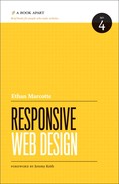
“The Way is shaped by use,
But then the shape is lost.
Do not hold fast to shapes
But let sensation flow into the world
As a river courses down to the sea.
, section 32, “Shapes”
By now, you have all the tools you need to start building responsive layouts. You’ve mastered the proportional thinking behind the flexible grid, investigated a few strategies for incorporating fixed-width media into your design, and explored how media queries can bring our designs beyond the desktop.
But up until this point, we’ve been looking at responsive design in a vacuum. In this chapter, let’s look at some different ways to begin incorporating it into our work, as well as a few paths to improve on some of the techniques we’ve already discussed.
A matter of context
As you begin experimenting, you’ll find that responsive designs, when properly built, can provide your visitors with a high level of continuity between different contexts. That’s because, at its most basic level, responsive design is about serving one HTML document to countless browsers and devices, using flexible layouts and media queries to ensure that design is as portable and accessible as possible.
However, certain web designers argue against this approach, suggesting that different devices should always be served different markup. In a rather lengthy blog post, mobile developer James Pearce questions the merits of responsive design (http://bkaprt.com/rwd/42/):
The fact that the user has a small screen in their hand is one thing—the fact that it is in their hand at all is another. The fact that the user may be walking, driving, or lounging is yet another. In fact, it’s quite likely that they really deserve different content and services altogether—or, at least, a differently prioritized version of the default desktop experience.
Jeff Croft (http://bkaprt.com/rwd/43/) puts it much more succinctly:
By and large, mobile users want different things from your product than desktop users do. If you’re a restaurant, desktop users may want photos of your place, a complete menu, and some information about your history. But mobile users probably just want your address and operating hours.
There are two prongs to this argument: first, that the device implies a context, telling us whether the user is stationary or mobile. From that context, we can create a class of users, and infer a set of goals. In other words, mobile users will want quicker access to different tasks than they would if they were on a desktop or laptop, where both time and bandwidth are on their side.
Second, if the user’s priorities and goals do indeed differ from one context to the next, then serving one HTML document to everyone won’t cut it. Take Jeff’s example: if the restaurant site features photos prominently at the top of every page, then chances are good that they’re near the top of the HTML. Which means that a mobile visitor, when presented with the same markup in a more linear fashion, will have to do a considerable amount of scrolling just to find the hours of operation they wanted.
For what it’s worth, I agree with these arguments—but up to a point. It’s absolutely fair to assume a user’s context from their device, but it’s just that: an assumption. For example, much of my “mobile” browsing happens on the couch in my living room, flipping idly through sites on my wireless network. Now, this isn’t just another of my “Ethan doesn’t have a life” jokes: research has shown that a significant percentage of people use “the mobile web” from the comfort of their home (http://bkaprt.com/rwd/44/, http://bkaprt.com/rwd/45/).
That’s not to say that the context question isn’t valuable, or that we shouldn’t be thinking about these difficult questions. But we can’t simply infer a user’s context from a class of devices—in many cases, the implementation of these separate, “context-aware” sites can often be lacking (FIG 5.1). Relying upon all-too-convenient terms like “mobile” and “desktop” is no substitute for conducting the proper research into how your audience accesses your site: not only the devices and browsers they use, but how, where, and why they use them.
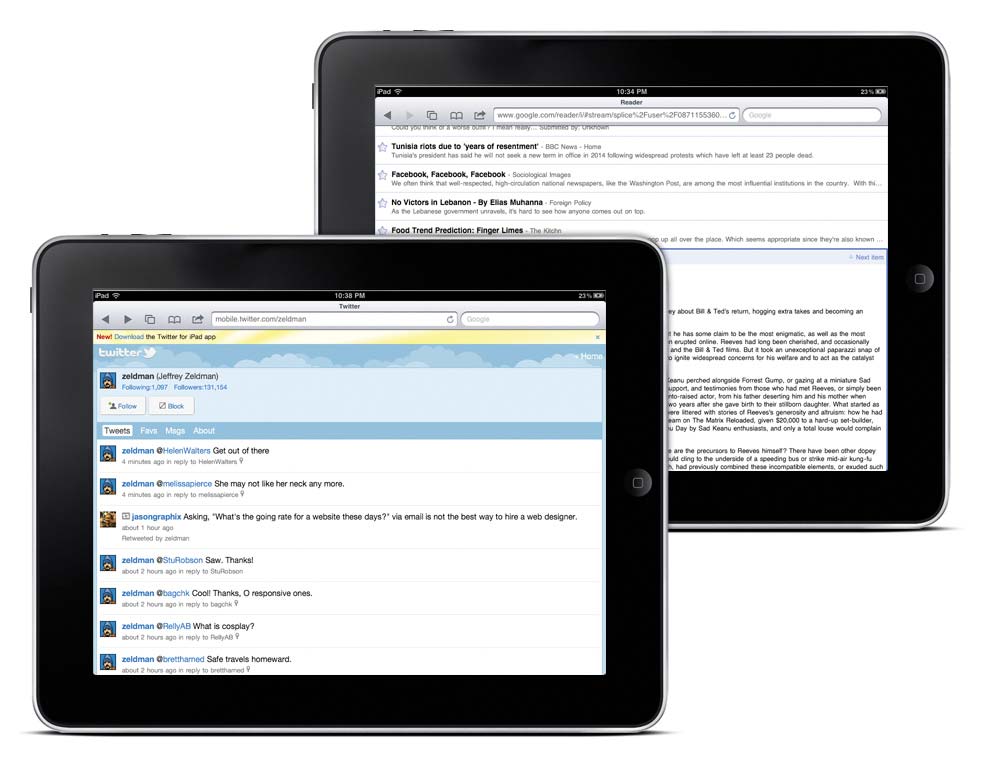
FIG 5.1: When viewed on an iPad, Google Reader and Twitter currently default to their “mobile” sites. Great design, but is it the right context?
But most importantly, responsive web design isn’t intended to serve as a replacement for mobile web sites. Responsive design is, I believe, one part design philosophy, one part front-end development strategy. And as a development strategy, it’s meant to be evaluated to see if it meets the needs of the project you’re working on. Perhaps there’s a compelling reason to keep your site’s desktop and mobile experiences separate, or perhaps your content would be better served by a responsive approach. Only you and your users know for certain.
While I agree with mobile web designers who say that certain users of certain sites deserve different content, I think the reverse is also true: many sites can benefit from serving one document up to multiple contexts or devices. And those are perfect candidates for a responsive approach.
So how do you know if responsive design is right for you?
Know thy users’ goals
In early 2010 I worked on a site called Cog’aoke (FIG 5.2), designed to promote a karaoke event hosted by my then-employer. Its main purpose was to provide visitors with information about the party, its sponsors, and its venue. But there was an application component as well: visitors could sign up to perform at the event, browse through the available catalog of songs, and vote for other prospective performers.

FIG 5.2: Behold Cog’aoke. Two different contexts, two different sites.
We also decided that the site needed a mobile-friendly component. But we envisioned something completely different from the desktop-specific site. We realized people stumbling to our event would need quick and ready access to the directions. Furthermore, we were going to have a live voting event at the show, and invite the audience to rate their favorite performer at a certain time—all through our site, accessed via their mobile phone.
As we were planning the site, it helped us to think of the desktop site as the “pre-game” experience. The mobile site, on the other hand, was really intended for the night of the event, for attendees who were physically present. So the goals of the two different contexts couldn’t have been more distinct.
With that in mind, it definitely would have been possible for
us to include all the markup for each context on every page of the site. If we’d taken
that route, every page would have had the regular “desktop” content marked up in its HTML,
as well as the map, directions, and voting information for the mobile site. And with those
two modes baked into every HTML page, we could have used some combination of media queries
and display: none to deliver the two sites to the right devices.
But that wouldn’t have been the right approach. We realized it would have been irresponsible of us to ask our visitors to download all that extraneous HTML, marking up content that they’d never see, much less benefit from. And I don’t say that just out of concern for mobile visitors: regardless of whether our visitors were on a phone-or a desktop-based browser, we would have been penalizing them with extra markup.
Meet “mobile first”
When you have a free moment (and a stiff drink in hand), I recommend browsing through Merlin Mann’s “Noise to Noise Ratio” Flickr set (http://bkaprt.com/rwd/46/). These screen grabs showcase some of the most content-saturated pages on the web: the pages are drowning in a sea of cruft. And the actual article, both paragraphs of it, is nigh unfindable.
While the sites in Merlin’s gallery might be new to you, I wager the problems they demonstrate are pretty familiar. What’s more, I think this trend informs some of our preconceptions about designing for “mobile” users: namely, we assume mobile users need less content in part because desktop users can tolerate more. After all, screens are larger, users are often more stationary, and can generally better focus on searching for the content they want.
But just because desktop users can sift through more content, does that mean they need to? In other words, why is easy access to key tasks only the domain of mobile users? Why can’t all users of our sites enjoy the same level of focused, curated content?
Toward the end of 2009, designer Luke Wroblewski fired off a little challenge to our industry, suggesting a website’s mobile experience shouldn’t be an afterthought (http://bkaprt.com/rwd/47/). Citing the explosive growth of mobile web traffic, as well as the exciting new technical capabilities of modern phones, Luke suggests that instead today’s web professionals should begin designing for mobile first.
“Mobile first” is a wonderful design philosophy. What’s more, I’ve found it absolutely invaluable for the responsive design projects I’ve worked on. As more browsers and devices begin accessing our designs, and as our clients become interested in designing beyond the desktop, it’s a perfect opportunity to take a hard look at how we design for the web: our processes and vocabulary, as well as the questions we ask and the solutions we apply.
Toward a responsive workflow
Of course, it’s the early days yet. Many designers, studios, and agencies are still learning about responsive design. As a result, we don’t have many “best practices” to share within our community. That’ll change over time, as we start thinking more responsively in our work. So in the meantime, I thought I’d share some of my experiences working with a more responsive workflow. Perhaps they’ll be helpful to you, and (more likely) you’ll find a way to improve upon them.
As I write this, I’m working on the redesign of a large, content-rich site. Over the course of a given day, a reader might access the site from home in the morning over coffee, read an article or two during their morning train commute, and possibly check in a few more times during the day.
Given the diversity of their readership, the client decided that a responsive approach would be the most appropriate one for their audience. So during the planning phases, the design team has taken a hard look at every proposed piece of content for the site, and asked one question: How does this content or feature benefit our mobile users?
Okay, maybe I should’ve made that sound a bit more exciting—I never was especially good at marketing. But it’s a question we’ve derived from the “mobile first” approach, and one we’ve found incredibly useful as the site’s designed. Here’s Luke’s rationale for the value of this thinking in site planning (http://bkaprt.com/rwd/48/):
If you design mobile first, you create agreement on what matters most. You can then apply the same rationale to the desktop/laptop version of the web site. We agreed that this was the most important set of features and content for our customers and business—why should that change with more screen space?
It’s all too easy to fill a desktop browser window with social media toolbars, links to related articles, battalions of RSS links, and tag clouds galore. (This process is called “adding value,” I believe.) But when we’re forced to work with a screen that’s 80% smaller than our usual canvas, nonessential content and cruft quickly fall away, allowing us to focus on the truly critical aspects of our designs.
In other words, designing for mobile devices first can enrich the experience for all users, by providing the element often missing from modern web design: focus. That’s not to say that our client’s pages are light on content, or lacking in features. But by framing our design process with that simple question, we’ve gained a handy acid test to apply when considering each proposed element, each new piece of functionality.
Identifying the breakpoints
Our design process kicks off by surveying the different devices for which we’re planning to design. From that research, we’ll compile a list of resolution breakpoints: horizontal widths we’ll need to accommodate in our responsive design. For example, our list might look like TABLE 5.1.
TABLE 5.1: A list of example resolution breakpoints.
|
320 pixels |
For small screen devices, like phones, held in portrait mode. |
|
480 pixels |
For small screen devices, like phones, held in landscape mode. |
|
600 pixels |
Smaller tablets, like the Amazon Kindle (600×800) and Barnes & Noble Nook (600×1024), held in portrait mode. |
|
768 pixels |
Ten-inch tablets like the iPad (768×1024) held in portrait mode. |
|
1024 pixels |
Tablets like the iPad (1024×768) held in landscape mode, as well as certain laptop, netbook, and desktop displays. |
|
1200 pixels |
For widescreen displays, primarily laptop and desktop browsers. |
That’s not to say that resolutions above or below this threshold will be ignored, or that we won’t accommodate some devices whose resolutions aren’t listed. (After all, the responsive layout will be based on a flexible grid, so there’s some resolution independence built in.) But building a list like this helps define a scope for our efforts, allowing us to identify the devices most commonly used by our audience, and how best to test against their respective resolutions.
With that list in hand, it’s time for the design to begin in earnest.
Iterative, collaborative design
Now, most design projects follow some version of the “waterfall” project management workflow, dividing the work into distinct, task-based phases. The specifics might change from one studio to the next, but there are usually four segments: a planning phase, a design phase, a development phase, and then, finally, delivery of the finished site. In each phase, documents or files are created—for example, a site map and wireframes during the planning phase—which the client approves before the next phase of work begins.
Again, the way you manage your projects might differ slightly. But for the design phase, the design team often mocks up a number of pages in a graphics editor like Photoshop, Fireworks, or the like. And once those mockups are finished and approved, they’re handed off to the development team, ready to be produced into static HTML templates.
But for a responsive site, that process can quickly become a bit unwieldy. Let’s pretend for a moment you’re redesigning a site with only one page, so you knock out a mockup in your favorite design application. But how do you communicate to your client how that page will appear on a phone? Or an iPad? Or a widescreen display? If you’ve the time, budget, and resources, it might be feasible for you to design each of those alternate views, presenting those comps to the client, gathering feedback, and then revising each as needed. But if you’re designing fifteen pages, or fifty, then it can quickly become impractical to produce every one of those mockups and their alternate views.
Recently, the responsive projects I’ve worked on have had a lot of success combining design and development into one hybrid phase, bringing the two teams into one highly collaborative group. I refer to this new, Voltron-esque phase as “designopment.” (No, not really.)
Our reviews begin with the design team presenting a page mockup to the entire group. This will typically be a desktop-centric design (FIG 5.3), although occasionally we might start with a more mobile-focused layout. The goal is to get a starting point in front of the entire group, to kick off a discussion about how this design will need to accommodate different resolution ranges and input types. Questions tend to fly back and forth pretty rapidly: “How do you envision this slideshow working on a touch interface?” “Is this module always going to be collapsed by default, or will desktop users need to see more information?” “How will this element look (and function) if JavaScript isn’t available?”

FIG 5.3: We’ll begin by reviewing a finished page comp, asking questions about how it should respond to different devices and browsers.
The open questions are a really great forum for the team to share ideas, to discuss how the design is intended to function on different displays, and to review any particularly complex pieces of interaction. If any design feedback needs action, then the design gets revised. But if the group feels comfortable, or if the revisions are sufficiently minor, then the development team inherits the comps for some prototyping.
“Prototyping before the designs are final, you say?” Absolutely, I say. Our goal is to get beyond the pixel limitations of Photoshop, and begin building a design that can flex and grow inside a changing browser window, that can scale to different devices. So the development team quickly begins producing a responsive design: converting the fixed grid into a fluid one, discussing ways to flexibly handle different types of media, and then finally applying the media queries that adapt our design to different resolution ranges.
Once our media queries are in place, we’re constantly resizing our browser window to approximate how the designs will hold up at different resolution ranges (FIG 5.4). Browser resizing extensions, such as the one included in the Web Developer Toolbar for Firefox and Chrome (http://bkaprt.com/rwd/49/), can be a huge help here; if you’ve established a list of resolution breakpoints like the one in TABLE 5.1, then you can simply store them in the extension for quick access later on (FIG 5.5).

FIG 5.4: As we’ve discussed, resizing your browser window is a great way to quickly test your design. But it’s only the first step.
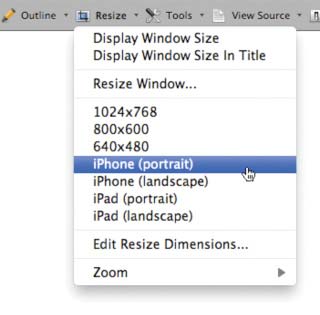
FIG 5.5: The “Resize” menu in the Web Developer Toolbar, with a few frequently used viewport sizes.
But as we discussed in the last chapter, resizing your browser window is really an intermediary step. If you want to test how your page is going to perform on a given device, there’s no substitute for viewing it on the actual device. (If you’re interested in setting up a mobile testing suite, I highly recommend Peter-Paul Koch’s article on the “Smartphone Browser Landscape,” available on A List Apart: http://bkaprt.com/rwd/50/. Heck, even if you’re not looking to purchase a small army of phones, it’s a great read.)
During this development process, a prototype begins to take shape. It’s based on the initial mockup supplied by the design team, of course, but as the development team codes they begin making recommendations about how the design should respond to different devices. In other words, during this collaboration the developers act as designers, too; they’re just designing in a different medium. They’re making design recommendations within the browser, rather than in Photoshop—recommendations that will be shared, tested, and vetted by the entire team.
Now, the prototype doesn’t have to be completely tested or production-ready. Because once that template’s somewhat finished, we start another design review—but this time, the design and development teams are reviewing code, not comps.
The interactive design review
To prepare for this meeting, we’ll load up the prototype page on several phones, tablets, laptops, and other target devices (FIG 5.6). When the meeting begins, the development team will introduce the page to the group, and then let everyone have at it. Because during the rest of the review, the entire group experiments with the design: on laptops and desktops, on phones and tablets. We’ll resize our browser windows, swipe through photo galleries, and test how usable forms are on both keyboards and touch screens.

FIG 5.6: The devices used in the jQuery Mobile testing suite. (Courtesy Filament Group, Inc., http://bkaprt.com/rwd/51/.)
But while everyone’s experimenting with the prototype, we try to keep a steady flow of conversation going. I’ve found it helps if the development team has a list of questions that came up as they were building the responsive design. Perhaps they noticed that a crucial link is a little too difficult to hit on a touch screen, or a maybe an animation is moving a little too slowly on a particular desktop browser. Calling out areas of interest or potential sticking points, and then asking for feedback, is a great way to get people talking about how well the design performs, and how it generally feels.
Because ultimately, the purpose of these reviews is to help vet the “live” design. After all, the initial mockup was used as a blueprint, providing layout rules, a typographic guide, and a pattern library; from there, the development team was responsible for adapting the design into its more responsive incarnation. In other words, we’re testing the design recommendations made by the development team, and discussing whether further refinement is needed. That refinement could either be a revised mockup, or some tweaks in the template. And once the meeting’s finished, the two halves of the group decamp with their respective feedback, and the process repeats itself. Review, design, build, and repeat.
Here’s a hypothetical example of how this back-and-forth works. Let’s say the design team’s mocked up a global navigation module, which includes a couple key links and a search field. And with that comp in hand, the development team’s dutifully built the navigation into the template (FIG 5.7).

FIG 5.7: The “desktop” view of the newly designed global navigation bar.
The design’s fairly straightforward, calling for two links displayed inline, with the search field to their right. And in making the design responsive, the development team settles on a fairly modest solution for smaller displays, choosing to give the search bar the full width of the page, and centering the two links beneath it (FIG 5.8).

FIG 5.8: At smaller resolution breakpoints, the links were initially placed beneath the search bar.
During the design review, a few design team members ask about the smaller version of the global navigation, as something about the elements’ placement feels a bit off to them. The search bar is considerably more prominent, sure, but some of the folks feel that maybe it’s too prominent, crowding out the links beneath it. And in fact, once they started interacting with the design on touch-enabled phones, they realize it’s a little too easy to tap into the search field when trying to activate a link.
So the coded version of the navigation isn’t quite working. And after discussing it for a bit, the design team comes up with an alternate solution (FIG 5.9). Instead of displaying the search bar at smaller resolutions, they decide to collapse it by default, making it appear as though it was just another link in the menu. But when that label is tapped or clicked on, the search bar appears as a dropdown beneath the rest of the menu (FIG 5.10).
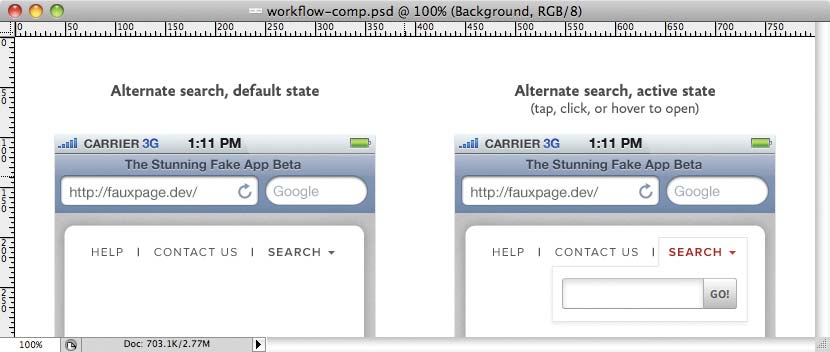
FIG 5.9: After discussing the problems at hand, the design team comes up with an alternate design for our problematic little navigation bar.

FIG 5.10: Our finished navigation bar, iteratively built by designers and developers.
That’s just one brief example of how this more collaborative approach can work. The key is to make this design/development cycle as iterative as it needs to be, with both groups constantly refining their work, and then sharing it with the group for review. For the project I’m working on, we’ve been meeting weekly for our interactive design reviews, but we’re constantly sharing sketches—whether in design or in code—via email throughout the week.
Ultimately, the goal is to close the gap between the traditional “design” and “development” cycles, to let the two groups collaborate more closely to produce a finished, responsive design. This more agile approach has allowed the groups I’ve worked on to use applications like Photoshop for design direction and guidance, but then quickly move into our real canvas: the browser.
Being responsive, responsibly
During our design/development cycle, the pages are constantly being refined as we build them, with the goal of finishing the phase with production-ready templates. And as we code our responsive design, we’ve found the philosophy of “mobile first” to be incredibly important.
Throughout the book, we’ve been using the Robot or Not site to
demonstrate how a fluid grid, flexible images, and media queries work together to provide
a more responsive approach to design. We began by taking our rigid mockup, designed in
Photoshop, and converting it into a fluid grid. As we saw in Chapter 4, that caused no end
of problems when we started resizing our browser window: our initial design wasn’t
intended to scale beyond its original context. So we introduced media queries to address
those issues, and to provide alternate small- and wide-screen layouts. And finally, for
browsers lacking native support for media queries, we included the respond.js
library to provide access to our alternate designs.
However, this approach raises another very real problem: what if an
@media-blind browser doesn’t have access to JavaScript? In that case, they’d
be forced to render our full, desktop-centric design, regardless of whether that’s
appropriate for their device. And for many mobile devices, that’s exactly what they’d see:
a design intended for a much wider screen, shoehorned into a tiny space (FIG 5.11).
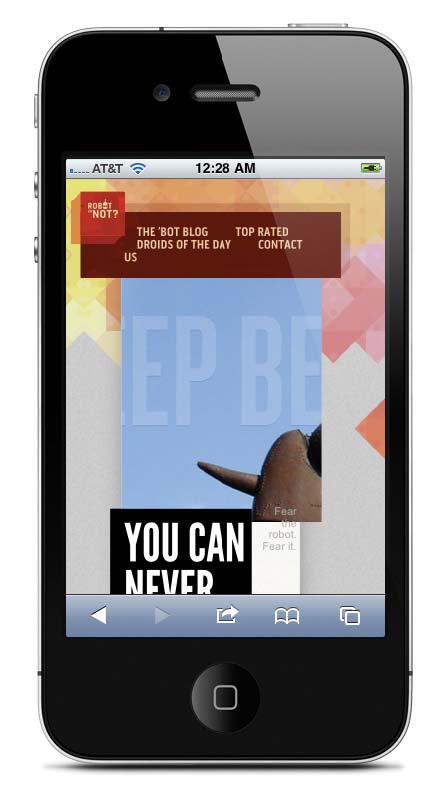
FIG 5.11: No media queries? No JavaScript? No good: our flexible, desktop-friendly layout tries to cram into a small space.
And there’s another problem with the way we’ve built the site. Here’s a brief snippet from the CSS:
.blog {
background: #F8F5F2 url("img/blog-bg.png") repeat-y;
}
@media screen and (max-width: 768px) {
.blog {
background: #F8F5F2 url("img/noise.gif");
}
}
First, we’re setting a background image on the .blog element. (Specifically,
the two-toned blog-bg.png graphic we used in Chapter 2 to create the illusion
of two columns.) Then for smaller displays, those narrower than 768px wide,
we’re instead placing a simple tiled GIF on the blog element, since we’ve linearized the
display of those narrower pages.
The problem with this approach is that some small screen browsers, most notably Mobile Safari on the iPhone and the iPad, will actually download both graphics, even if only one is ultimately applied to the page. While smaller screens don’t always equate to lower bandwidth, we’re currently punishing users on smaller screens with the download of a much heavier image than they’ll ever see.
Thankfully, these aren’t problems with responsive design in and of itself—we just need to rethink the way we’ve implemented it.
“Mobile first” meets media queries
Speaking broadly, responsive design is about starting from a reference resolution, and using media queries to adapt it to other contexts. A more responsible approach to responsive design would mean building our stylesheet with “mobile first” in mind, rather than defaulting to a desktop layout. So we’d begin by defining a layout appropriate to smaller screens, and then use media queries to progressively enhance our design as the resolution increases.
In fact, I took this approach on my personal portfolio site (http://ethanmarcotte.com). By default, the content is arranged in a very linear manner, one friendly to mobile devices and narrow browser windows (FIG 5.12). But as the viewport widens, the grid becomes more complex and more asymmetrical (FIG 5.13). And at the highest end of the spectrum, the “full” design finally reveals itself: the layout becomes even more complex, and some heavier assets, like that big abstract background image, are introduced (FIG 5.14).
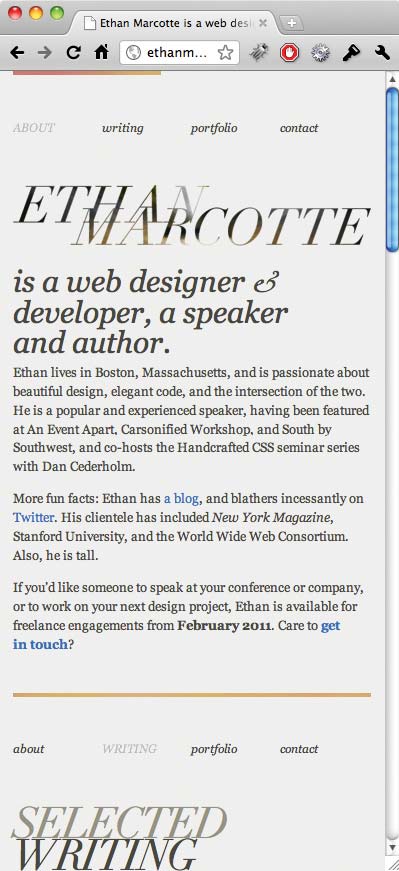
FIG 5.12: The default, small screen-friendly design.
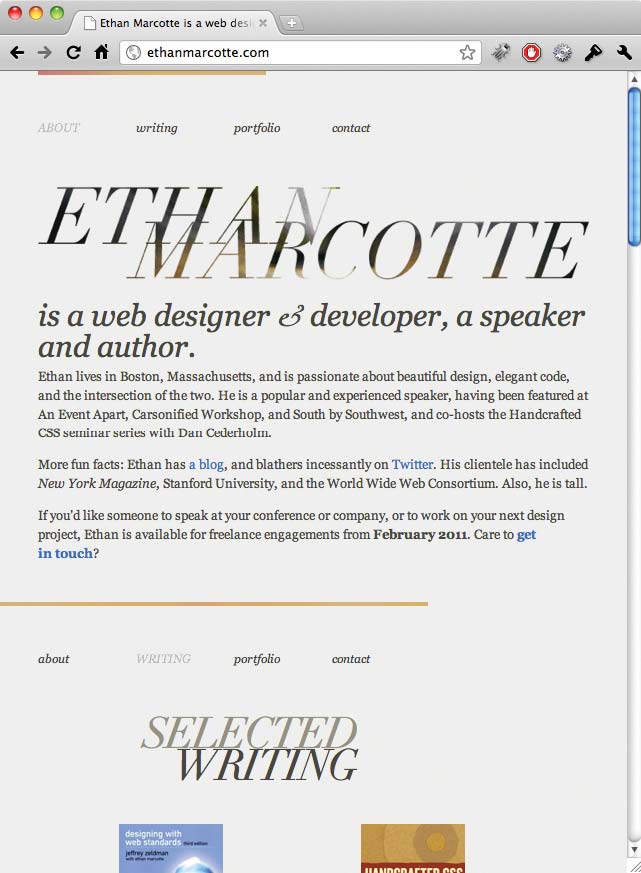
FIG 5.13: At the halfway mark, some complexity is introduced.
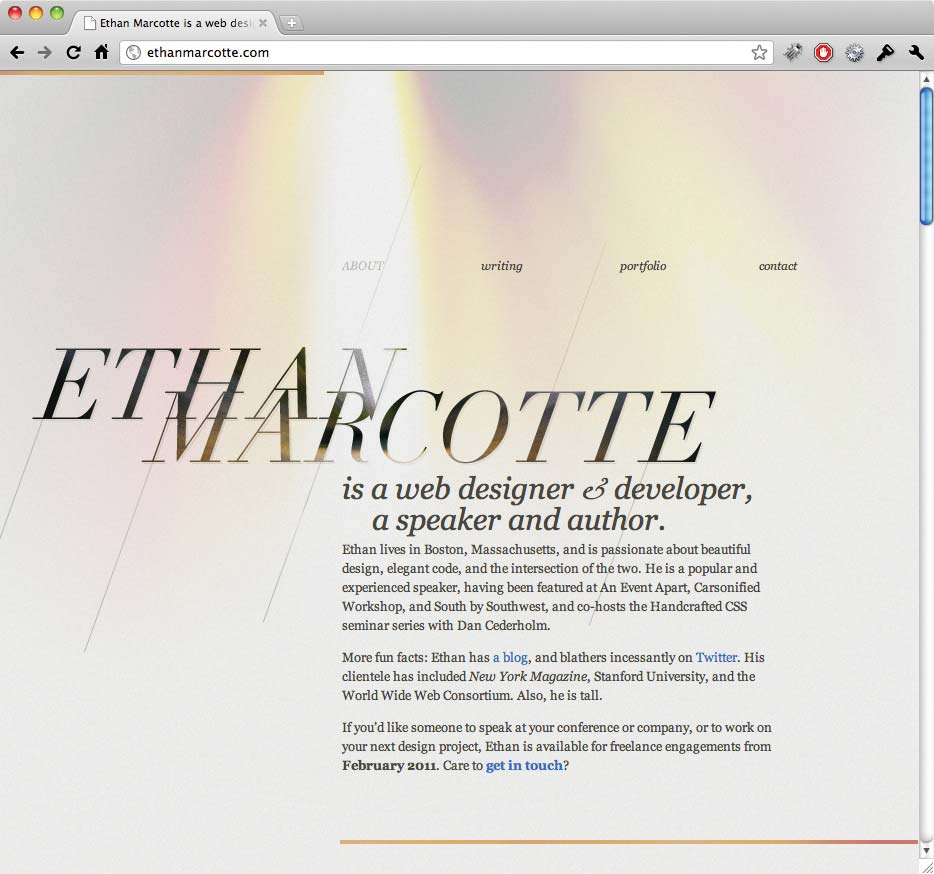
FIG 5.14: Finally, the full design appears at the higher end of the resolution spectrum, progressively enhanced with media queries.
The design is still responsive, using all of the techniques we’ve discussed thus far in
this book: the layout is based on a fluid grid, and the images still work well within that
flexible context. But in contrast to the Robot or Not site, I’m applying
min-width media queries to scale our design up through the
resolution spectrum. The basic structure of the stylesheet looks something like this:
/* Default, linear layout */.page { margin: 0 auto; max-width: 700px; width: 93%; }/* Small screen! */@media screen and (min-width: 600px) {…}/* "Desktop" */@media screen and (min-width: 860px) {…}/* IT'S OVER 9000 */@media screen and (min-width: 1200px) {…}
The bulk of the stylesheet contains little else but color- and type-related rules,
providing a basic (but hopefully still attractive) design to all users. Then, four
resolution breakpoints are set in the media queries, for minimum viewport widths of
480px, 600px, 860px, and 1200px. And
as the resolution scales up beyond those thresholds, the appropriate layout rules are
applied. But if a browser without media query support accesses my site, they’re given an
attractive, single-column layout if our JavaScript patch isn’t available to them (FIG 5.15).
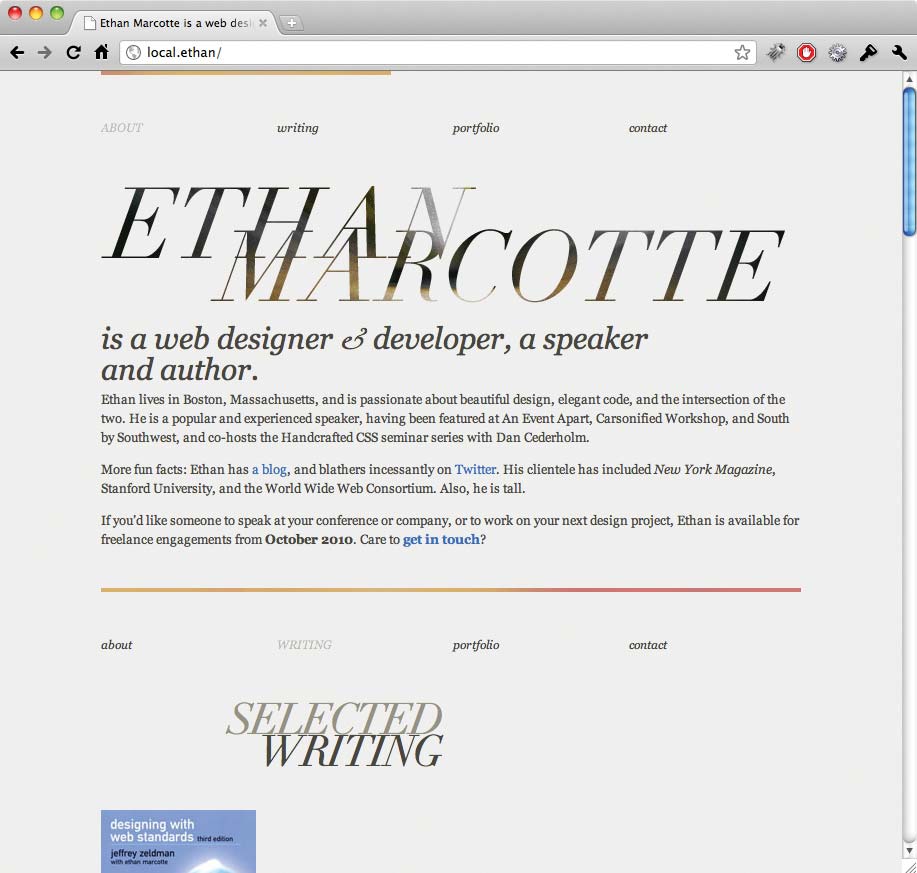
FIG 5.15: No media queries? No JavaScript? This time, no problem.
This “mobile first” approach to building responsive templates ensures greater accessibility to our content, but doesn’t make any assumptions about the capabilities of the device or browser rendering our design. And after adopting it for a number of client projects, I believe it’s the best, most bulletproof way to implement your responsive designs.
Revisiting progressive enhancement
A more thorough implementation of this approach would be the recent redesign of Yiibu (http://yiibu.com), a mobile-focused design studio. Bryan and Stephanie Rieger, Yiibu’s founders, call the redesign a merger of “mobile first” and responsive design, and describe their approach thusly (http://bkaprt.com/rwd/52/):
The base content and default presentation are mobile, and optimized for the very simplest devices first. We’ve defined this as “basic” support. Devices with small screens and media query support are served an enhanced layout—and occasionally—more complex content. We’ve called this ”mobile.” Finally, the layout and content are enhanced to reflect the “desktop” context.
The language is different, of course, but it overlaps beautifully with Nick Finck and Steven Champeon’s original definition of “progressive enhancement” (http://bkaprt.com/rwd/53/):
Rather than hoping for graceful degradation, progressive enhancement builds documents for the least capable or differently capable devices first, then moves on to enhance those documents with separate logic for presentation, in ways that don’t place an undue burden on baseline devices but which allow a richer experience for those users with modern graphical browser software.
Since Nick and Steven coined the term in 2003, progressive enhancement has been the hallmark of the responsible approach to standards-based web design. By beginning with a foundation of semantic, well-structured markup, styled with a layer of CSS, and DOM scripting via JavaScript added as needed, we can create compelling experiences in capable browsers, while ensuring universal access to the content beneath the design.
Stephen Hay reiterated the need for progressive enhancement as well, in his fantastic essay “There is no Mobile Web” (http://bkaprt.com/rwd/54/):
Most sites on the web are not built with specific mobile use-cases in mind. However, millions of people access these sites every day through mobile devices. They access a “normal” (whatever that means) website through their “mobile” device.
…
To be honest, I can think of a few, but not many use cases of web sites or apps which are or should be exclusively mobile. It seems like the Mobile Web allows us to revisit all of the talk of inclusion, progressive enhancement, and accessibility from years ago.
Ever have one of those moments where someone else perfectly expresses why you believe in something? Stephen’s essay manages to capture exactly why I’m excited about responsive web design. Rather than simply siloing our content into different, device-specific sites, we can use progressive enhancement to ensure quality access for all, with an enhanced experience for those devices that are capable of it.
Working with JavaScript
To put this to the test, let’s take a look at the slideshow at the top of the Robot or Not site (FIG 5.16). Currently, the markup looks like this:
<div class="slides">
<div class="figure">
<b><img src="img/slide-robot.jpg" alt="" /></b>
<div class="figcaption">…</div>
</div><!-- /end .figure -->
<ul class="slide-nav">
<li><a class="prev" href="#">Previous</a></li>
<li><a class="next" href="#">Next</a></li>
</ul>
</div><!-- /end .slides -->

FIG 5.16: Our slideshow. Or at least, a completely non-functional facsimile thereof.
Not too fancy. But also, not too functional: we’ve marked up the interface for a slideshow, but it isn’t implemented yet. We’ve included a single slide in our template, as well as the previous/next navigation. But clicking on those links won’t do a darned thing.
So, we’ll need to introduce a bit of JavaScript, and bring some interactivity into our design. But first, we need slides! So, let’s grab some more images, and augment our HTML a bit:
<div class="slides">
<div class="figure">
<b><img src="img/slide-robot.jpg" alt="" /></b>
<div class="figcaption">…</div>
</div><!-- /end .figure -->
<div class="figure">
<b><img src="img/slide-tin.jpg" alt="" /></b>
<div class="figcaption">…</div>
</div><!-- /end .figure -->
<ul class="slide-nav">
<li><a class="prev" href="#">Previous</a></li>
<li><a class="next" href="#">Next</a></li>
</ul>
</div><!-- /end .slides -->
Let’s drop in four more slides, using the same .figure
markup pattern as before.
This looks a little weird right now, as our slides are currently just stacked on top of each other (FIG 5.17). So to get our slideshow up and running, we’ll be using a free jQuery plugin designed by developer Mat Marquis (http://bkaprt.com/rwd/55/). It’s one of the more robust slideshow scripts I’ve used. I like it because it works incredibly well with flexible content; if your slides have different amounts of text or images in them, this plugin handles them with ease—all without resorting to convoluted CSS foofery. (Oh, yes. I said “foofery.” I’m not messing around.)
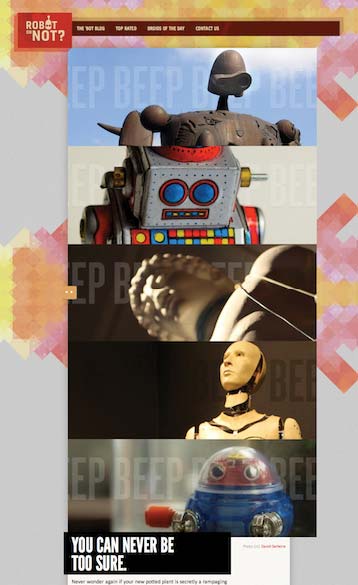
FIG 5.17: New slides: we add them. Stacked images: we hate them.
So to work the carousel script into the page, I’m going to add three new
script elements to our HTML:
<script src="jquery.js"></script> <script src="carousel.js"></script> <script src="core.js"></script>
Since Mat’s carousel script requires jQuery to run, I’ve downloaded the library from http://jquery.com and placed it in the head of
the page (jquery.js), followed by Mat’s script (carousel.js),
and a file called core.js, which is where we’ll actually write the code for
our slideshow.
And actually, it’s fairly easy to do. Inside of core.js , let’s write the
following:
$(document).ready(function() {
$(".welcome .slides")
.wrapInner('<div class="slidewrap">
<div id="welcome-slides" class="slider">
</div></div>')
.find(".slidewrap")
.carousel({
slide: '.figure'
});
});
Now, if you’re not completely comfortable with JavaScript, or haven’t used jQuery before, that’s okay. The script above is doing a few different things:
- First, it locates the
div.slideselement inside of the.welcomemodule, using jQuery’s very CSS-friendly selector syntax. ($(".welcome .slides")). - Once it’s located that element, it wraps the contents with some markup that’s required
by the carousel script. (
.wrapInner(…)) - With that new HTML in place, our script runs the
.carousel()function, creating the slideshow. And since we’ve marked up individual slides with the.figureclass, that’s what we’ve told the script to use.
And with those eight lines of JavaScript, we’ve got a working slideshow (FIG 5.18). Success!

FIG 5.18: The slideshow lives. It lives!
Lazily (but intelligently) loading content
Or at least, it’s a starting point. If we disabled JavaScript in the browser, we’re back to where we were before: with slides stacked on top of each other, and with a navigation menu that doesn’t actually do anything. So for any visitor to our site that doesn’t have JavaScript available to them, the experience quickly becomes decidedly un-great. So let’s address those issues.
First, let’s remove the previous/next navigation from our markup, and insert it via JavaScript.
$(document).ready(function() {
var sNav = [
'<ul class="slide-nav">',
'<li><a class="prev" href="#welcome-slides">Previous</a></li>',
'<li><a class="next" href="#welcome-slides">Next</a></li>',
'</ul>'
].join("");
$(".welcome .slides")
.wrapInner('<div class="slidewrap"><div id="welcome-slides" class="slider"></div></div>')
.find(".slidewrap")
.append(sNav)
.carousel({
slide: '.figure'
});
});
Our code looks quite a bit more complex now, but we’ve really only introduced one new
piece of functionality. First, we’re declaring a variable called sNav, which
stores the HTML for our slide navigation. Then, just before the carousel()
function is called, we’re inserting that markup into our slideshow. By using jQuery to
insert the navigation into the page, we’ve ensured that users without JavaScript won’t see
it. Progressive enhancement in action.
Now, that doesn’t solve the problem of our stacked images. For that, we’re going to get a bit tricky: we’re going remove all but one of the slides from the page, and put them in a separate HTML file. So now, our page’s source looks considerably lighter:
<div class="slides">
<div class="figure">
<b><img src="img/slide-robot.jpg" alt="" /></b>
<div class="figcaption">…</div>
</div><!-- /end .figure -->
</div><!-- /end .slides -->
However, we’ve created a separate file (let’s call it slides.html), and
pasted in the markup for our four remaining slides:
<div class="figure"> <b><img src="img/slide-tin.jpg" alt="" /></b> <div class="figcaption">…</div> </div><!-- /end .figure --><div class="figure"> <b><img src="img/slide-statue.jpg" alt="" /></b> <div class="figcaption">…</div> … </div><!-- /end .figure -->
You’ve probably noticed that slides.html isn’t even a valid HTML document.
In fact, it’s more like a markup stub, a mini-document we can use to store some
HTML for later use. In fact, we’ll just use jQuery to open slides.html and
load the images into the slideshow, like so:
$(document).ready(function() {
$.get("slides.html", function(data) {
var sNav = [
'<ul class="slide-nav">',
'<li><a class="prev" href="#welcome-slides">Previous</a></li>',
'<li><a class="next" href="#welcome-slides">Next</a></li>',
'</ul>'
].join("");
$(".welcome .slides")
.append(data)
.wrapInner('<div class="slidewrap"><div id="welcome-slides" class="slider"></div></div>')
.find(".slidewrap")
.append(sNav)
.carousel({
slide: '.figure'
});
});
});
And that’s that. The jQuery .get() function opens our HTML
snippet (slides.html), and inserts its contents into our module by using
append(). If JavaScript isn’t available, or if jQuery can’t load that file,
then the user is presented with a single image at the top of the page: a perfectly
acceptable fallback for our design (FIG 5.19).
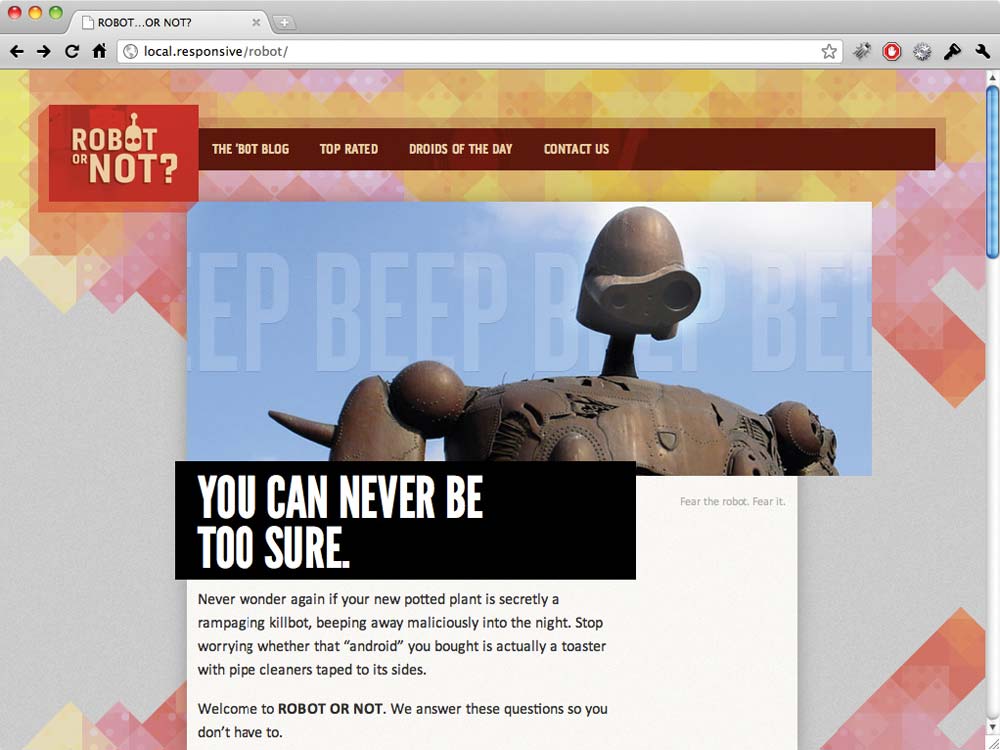
FIG. 5.19: No JavaScript? No problem. Our slideshow degrades to a single image, which looks just grand.
Further improvements
We’ve augmented our simple slideshow script with considerably more code, but the end result is a much more robust and accessible experience. We’re not assuming anything about the capabilities of the browser or device rendering our page: if JavaScript is available to them, then our slideshow will appear.
But there’s always room for improvement—and this rough little prototype is no exception. For example, we could potentially restrict our slideshow to only appear on certain types of displays, making the script resolution dependent. For example, if we wanted to prevent it from loading at all on smaller screens, we could work a simple resolution test into our script:
if (screen.width > 480) {
$(document).ready(function() { … });
}
That opening if statement is the JavaScript equivalent of a min-width:
480px media query: if the screen is narrower than 480 pixels, then the enclosed
JavaScript won’t fire (FIG 5.20).

FIG 5.20: We’ve decided that our slideshow
will only be available to browsers wider than 480px. Smaller screens get a
single image.
And we could refine this approach further. For example, we would ideally use a
lightweight JavaScript loader like LabJS (http://labjs.com/) or Head JS (http://headjs.com/)
to dynamically load jQuery, the carousel plugin, and our own custom.js,
perhaps including them only if the user’s screen is above a certain resolution threshold.
That would help ensure that users on smaller screens aren’t saddled with the overhead of
downloading all that JavaScript, especially if we’re keeping the carousel from loading for
them. And while we’re being bandwidth-conscientious, I’d probably use Filament Group’s
fantastic “responsive images” library (http://bkaprt.com/rwd/56/), which would allow us to serve lighter, more
bandwidth-friendly images to smaller displays, with the full-sized images served only to
wider screens.
Go forth and be responsive
I mention these enhancements not because they’re necessarily the right approach; in the age of portable 3G hotspots and wifi-enabled phones, it can be dangerous to automatically equate a screen’s dimensions with the bandwidth available to it. But if you need an extra level of resolution awareness in your work, these tools are available.
Still, I find it helpful to keep Luke’s “mobile first” philosophy in mind when I’m faced with a particularly involved bit of functionality. If I’m disabling a tricky interface for mobile users, then why is there value in it for the rest of my audience? If that sounds like a loaded question, it’s not meant to be: there aren’t any easy answers here.
Because more than anything, web design is about asking the right questions. And really, that’s what responsive web design is: a possible solution, a way to more fully design for the web’s inherent flexibility. In the first chapter, I said that the ingredients for a responsive design were a fluid grid, flexible images, and media queries. But really, they’re just the vocabulary we’ll use to articulate answers to the problems our users face, a framework for ordering content in an ever-increasing number of devices and browsers.
If we’re willing to research the needs of our users, and apply those ingredients carefully, then responsive web design is a powerful approach indeed.
I can’t wait to see the stories you’ll tell with it.
